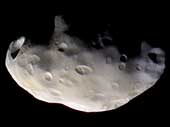
Saturn X - 1980S26
Pandora [pan-DOR-uh] is the fourth of Saturn's known satellites. It was discovered from photographs taken by Voyager during its encounter with Saturn by S. Collins and others. Pandora is the outer shepherd satellite for Saturn's F-ring. It has a diameter of about 114 by 84 by 62 kilometers (71 by 52 by 38 miles) and appears to be very heavily cratered. The two largest craters are about 30 kilometers (19 miles) in diameter. No linear valleys or ridges are visible. Very limited data is available to analyze Pandora.
| Pandora Statistics | |
|---|---|
| Discovered by | S. Collins & others |
| Date of discovery | 1980 |
| Mass (kg) | 2.2e+17* |
| Mass (Earth = 1) | 3.6814e-08 |
| Radius (km) | 57x42x31 |
| Radius (Earth = 1) | 8.9370e-03 |
| Mean density (gm/cm^3) | 0.7* |
| Mean distance from Saturn (km) | 141,700 |
| Rotational period (days) | ? |
| Orbital period (days) | 0.6285 |
| Mean orbital velocity (km/sec) | 16.40 |
| Orbital eccentricity | 0.004 |
| Orbital inclination (degrees) | 0.0 |
| Escape velocity (km/sec) | 0.0227 |
| Visual geometric albedo | 0.9 |
| Magnitude (Vo) | 16.5 |
 Pandora's Color Close-up
Pandora's Color Close-up
Cassini's best close-up view of Saturn's F ring shepherd moon, Pandora,
shows that this small ring-moon is coated in fine dust-sized icy material.
Craters formed on this object by impacts appear to be covered by debris, a process that probably happens rapidly in a geologic sense. The grooves and small ridges on Pandora (84 kilometers, or 52 miles across) suggest that fractures affect the overlying smooth material.
The crisp craters on another Saturn moon, Hyperion, provide a contrasting example of craters on a small object (see PIA07740).
Cassini acquired infrared, green and ultraviolet images on Sept. 5, 2005,
which were combined to create this false-color view. The image was taken
with the Cassini spacecraft narrow-angle camera at a distance of
approximately 52,000 kilometers (32,000 miles) from Pandora and at a
Sun-Pandora-spacecraft, or phase, angle of 54 degrees. Resolution in the
original image was about 300 meters (1,000 feet) per pixel. The image has
been magnified by a factor of two to aid visibility.
(Courtesy NASA/JPL/Space Science Institute)
 Pandora
Pandora
This image of Pandora was acquired by the Voyager 2 spacecraft on
August 25, 1981.
(Copyright Calvin J. Hamilton)
 Shaded Map of Pandora
Shaded Map of Pandora
This is a shaded relief map of Pandora, the outer F Ring
shepherd
satellite of Saturn. As with all maps, it is the cartographer's
interpretation and not all features are necessarily certain given the
limited data available.
This interpretation stretches the data as far as
is feasible. The leading side faces forwards in the orbit of Pandora.
The trailing side faces backwards along the orbit.
Longitude 0 is at the righthand end of the leading side, and faces Saturn.
As with all conformal (true shape) projections, the scale in these maps
varies, increasing from the center to the outer edge.
(Courtesy Phil Stooke).
 Prometheus and Pandora
Prometheus and Pandora
This image shows Saturn's thin F-Ring with shepherd satellites
Prometheus and
Pandora. Prometheus is the inner moon and Pandora the outer.
This is a zoomed in section from the image
fring5.htm.
(Copyright Calvin J. Hamilton)
Stooke, P. J., "Shapes and Surface Features of Prometheus and Pandora," Earth, Moon and Planets, 62 (1993), 199-221.

 Saturn
Saturn Prometheus
Prometheus Epimetheus
Epimetheus